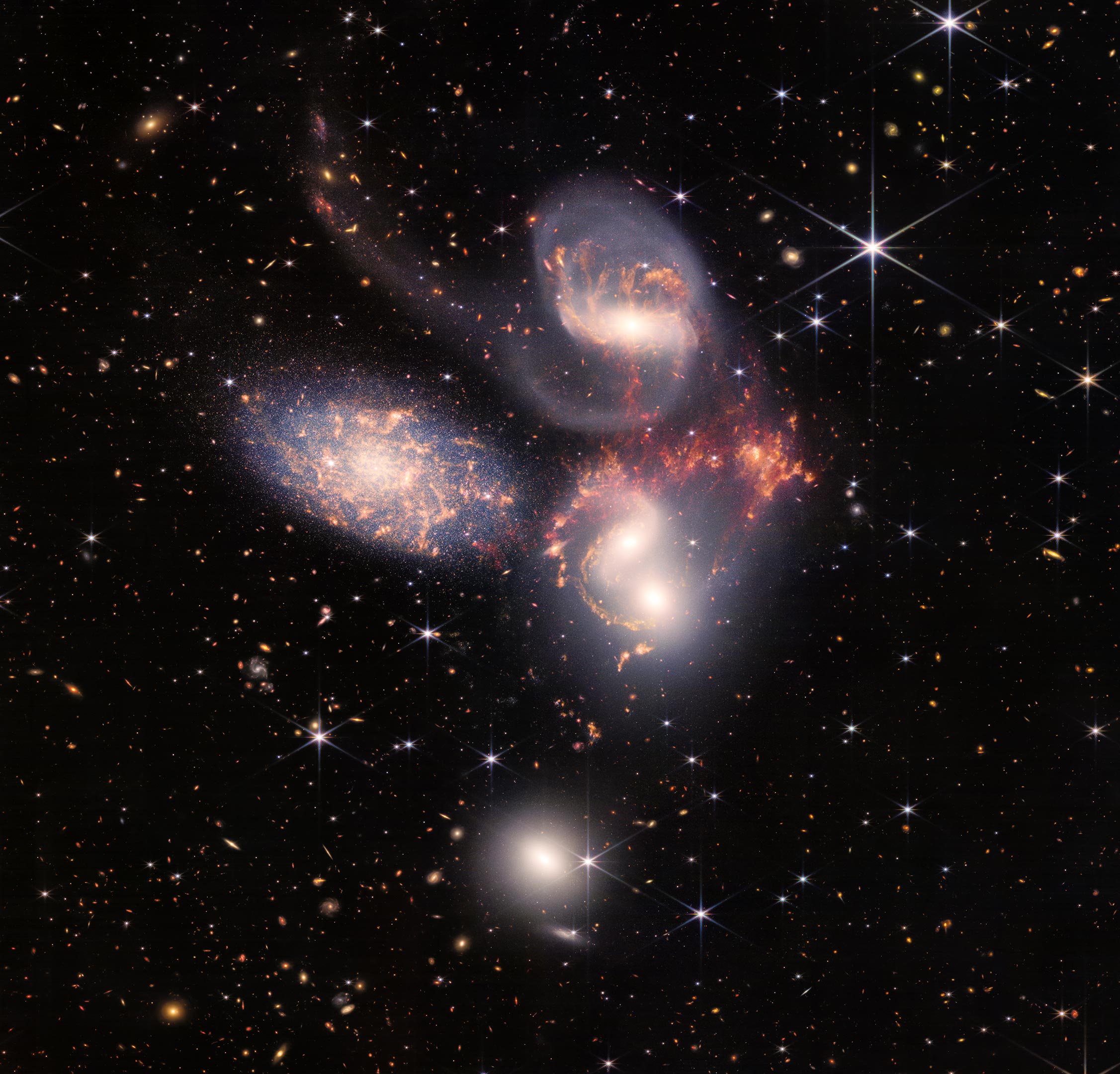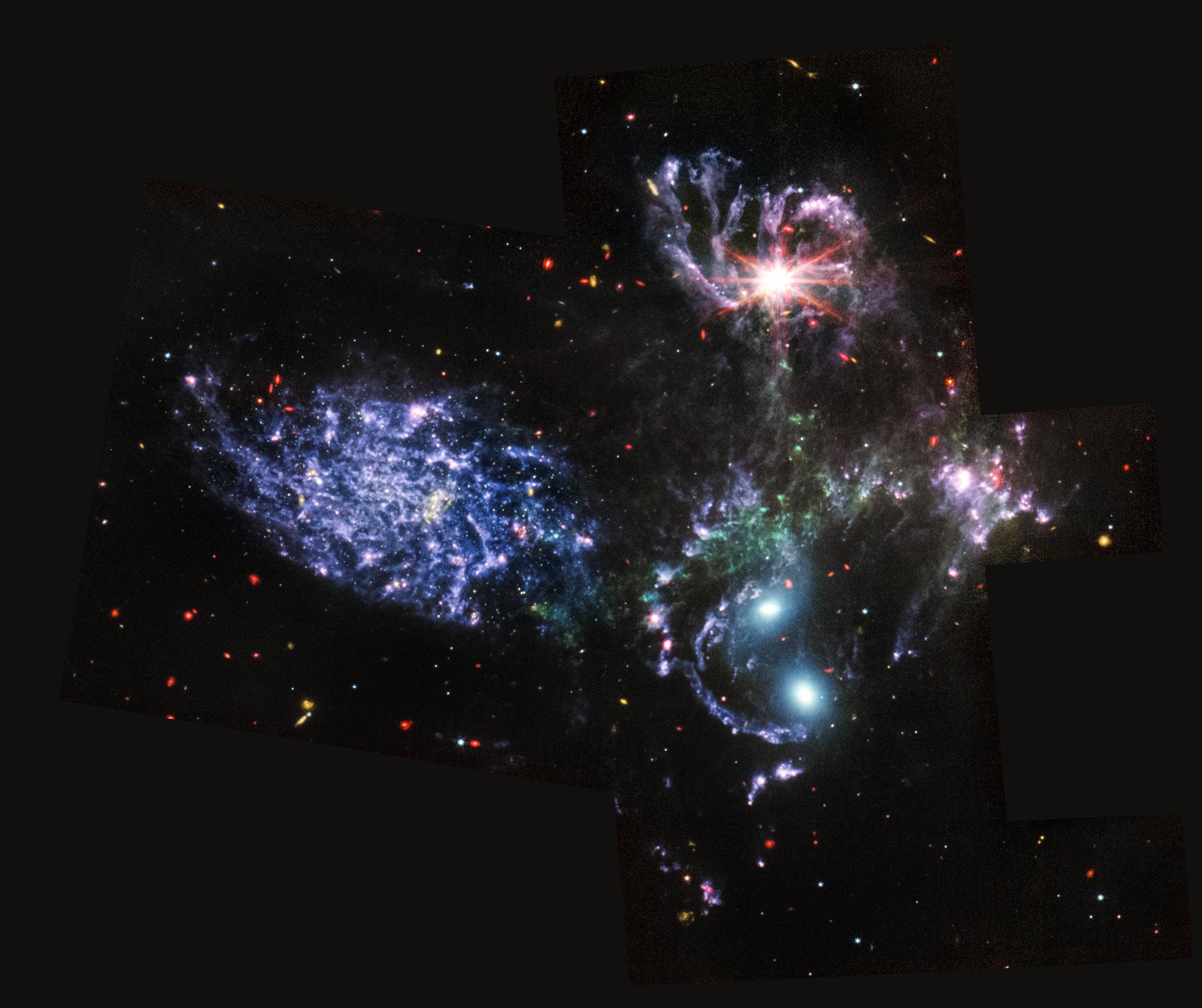NASA’s James Webb Space Telescope reveals never-before-seen details of the galaxy group called “Stephan’s Quintet” in an enormous new image. The close proximity of this group gives scientists a ringside seat to galactic mergers and interactions. Astronomers rarely see in so much detail how interacting galaxies trigger star formation in each other, and how the gas in these galaxies is being disturbed. Stephan’s Quintet is a fantastic “laboratory” for studying these processes fundamental to all galaxies. In a level of detail never seen before, the image also shows outflows driven by a supermassive black hole in one of the group’s galaxies. Tight galaxy groups like this may have been more common in the early universe when superheated, infalling material may have fueled very energetic black holes.

NASA’s Webb Sheds Light on Galaxy Evolution, Black Holes
Best known for being prominently featured in the classic Christmas film, “It’s a Wonderful Life,” Stephan’s Quintet is a stunning visual grouping of five galaxies. Now, NASA’s James Webb Space Telescope reveals Stephan’s Quintet in a new light.
Webb shows never-before-seen details in this galaxy group thanks to its powerful, infrared vision and extremely high spatial resolution. Sparkling clusters of millions of young stars and starburst regions of fresh star birth grace the image. Sweeping tails of gas, dust, and stars are being pulled from several of the galaxies due to gravitational interactions. Most dramatically, the Webb Space Telescope captures huge shock waves as one of the galaxies, NGC 7318B, smashes through the cluster.

Together, the five galaxies of Stephan’s Quintet are also known as the Hickson Compact Group 92 (HCG 92). Although called a “quintet,” only four of the galaxies are actually close together and caught up in a cosmic dance. The fifth and leftmost galaxy, called NGC 7320, is well in the foreground compared with the other four. In fact, NGC 7320 resides just 40 million light-years from Earth, while the other four galaxies (NGC 7317, NGC 7318A, NGC 7318B, and NGC 7319) are around 290 million light-years away. This is still fairly close in cosmic terms, compared with more distant galaxies billions of light-years away. Studying such relatively nearby galaxies like these helps astronomers better understand structures seen in a much more distant universe.
This proximity provides scientists a ringside seat for witnessing the merging and interactions between galaxies that are so crucial to all of galaxy evolution. Rarely do astronomers witness in so much detail how interacting galaxies trigger star formation in each other, and how the gas in these galaxies is being disturbed. Stephan’s Quintet is an excellent “laboratory” for studying these processes fundamental to all galaxies.
Tight groups like this may have been more common in the early universe when their superheated, infalling material may have fueled very energetic black holes called quasars. Even today, the topmost galaxy in the group – NGC 7319 – harbors an active galactic nucleus, a supermassive black hole that is about 24 million times the mass of the Sun. It is actively pulling in material and puts out light energy equivalent to 40 billion Suns.
Combined with the most detailed infrared image ever of Stephan’s Quintet from MIRI and the Near-Infrared Camera (NIRCam), the data obtained by Webb will provide a bounty of valuable, new information. For instance, it will help astrophysicists understand the rate at which supermassive black holes feed and grow. Webb also sees star-forming regions much more directly, and it is able to examine emissions from the dust – a level of detail that was previously impossible to obtain.
SciTech Daily
It’s appropriate here to refer to the thesis of The Privileged Planet, which argues that Earth is…
An Exceptional Platform for Discovery
The basic thesis of TPP is that the best places for intelligent observers are also the best places for observing. A corollary is that Earth is both an exceptionally habitable place and an exceptional platform for discovery. It is an empirical cumulative case argument. If it is a fair statement about reality, then I expect the TPP thesis to strengthen as we gain knowledge in astronomy, physics, and the Earth sciences.
The stunning images from the James Webb Space Telescope have only strengthened the assertion that a feature of Earth is its ideal location within the spacetime of the cosmos, allowing remarkable discoveries about our universe.